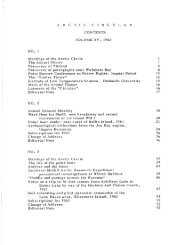Volume 4, 1951 - The Arctic Circle - Home
Volume 4, 1951 - The Arctic Circle - Home
Volume 4, 1951 - The Arctic Circle - Home
Create successful ePaper yourself
Turn your PDF publications into a flip-book with our unique Google optimized e-Paper software.
f the route offered good footing on an elevated gravel<br />
1dge. Exploration of Dawson Bay revealed the presence of<br />
ny lime-loving plants, but perhaps the most interesting<br />
eature is the numerous salt springs around which grow plants<br />
ore normally found along coastal salt marshes. On the return<br />
to the Grand Rapids portage, the lightened canoes were<br />
un down the awe-inspiring rapids, covering in one part a<br />
1stance of two miles in six minutes. <strong>The</strong> party returned<br />
to Winnipeg on the S.S. ~~enoFa, a steamboat originally<br />
lying Lake of the Woods, but rebuilt on Lake Winnipeg, and<br />
now rounding out its ancient life in serving isolated comunities<br />
along the stormy waters of this shallow remuant of<br />
lacial Lake Agassize<br />
Besides the writer, the 1949 field party again inluded<br />
Nick Neufeld and Jim Robinson, together with John<br />
• Campbell of Hamilton, Onta~io. <strong>The</strong> route led down the<br />
elson River from Nc:rway House: across nFainted Stone<br />
ortage" on the height of lal1(}at. the hGadw·~J.te!"s of the<br />
ohimamish, and j.nto the Hayes River system. <strong>The</strong> greater<br />
art of the Hayes lies in th8 Procambrian, and includes a<br />
,hain of lakes bearing the names Robinson, Logan, Max, Windy,<br />
xford, Knee, and S'tJ':é'.mpy" Many portages are necessary in the<br />
ntervening reaches. About hO miles belmv SW8lnPy Lake, or<br />
bout 100 miles above York F~ctory, the river enters the<br />
laeozoic formations of the Hudson Bay Lowlands, and winds<br />
ith great regularity between clay banks )0 to 100 feet<br />
19h, the only obstructions to canoe travel being the<br />
hallowness of the water and the occurrence of gravel bars<br />
t each bend. <strong>The</strong> flora of this section includes many limeoving<br />
species absent from the Precambrian formations to the<br />
est. This is particularly so along the gravel beaches and<br />
ars, where, in the absence of competing forest species,<br />
sses of tansy, arnica, hedysarQffi,arctie vetch, painted-cup,<br />
iver-beauty, and other northern species produce a breathaking<br />
blaze of colour. <strong>The</strong> arctic influence is evident<br />
ound York Factory, where such northern cireQ~polar species<br />
.s a grass (Dupomia Fisheri forma p.§~.lQ..santha), a willow<br />
Salix reticulataJ, and arctic daisy \ ~rysanthemum arcticum)<br />
e found.<br />
Following a week of collecting around York Factory,<br />
he party rounded the shallow and treachercus tidal waters .<br />
ff Marsh Point and entered the estuary of the Nelson. <strong>The</strong><br />
ift water and many rapids of the eighty-mile stretch to<br />
imestone Rapids, at which point contact was made with the<br />
udson Bay Railway, made it necessRry to line the heavily<br />
oaded canoes for conside:"able dis~D.J::.:;9S, psrticularly around<br />
e numerous limestor-e headlands. ~he r8main~ng part of the<br />
eason was spent in the area of Wekasko and Tramping Lakes,












